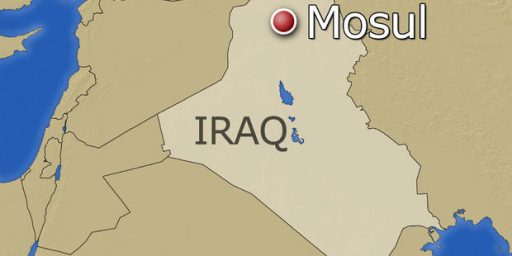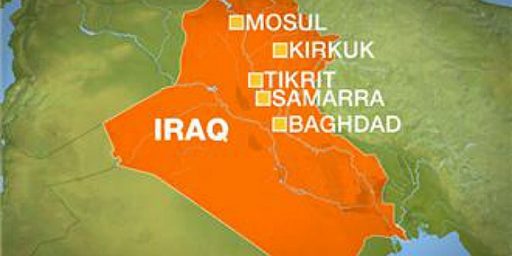What We Won in Falluja
Max Boot explains “What We Won in Fallouja” in his latest LAT column.
Coalition troops killed 1,200 to 1,600 guerrillas and captured more than 1,000. They uncovered 26 bomb factories, 350 arms caches (containing thousands of weapons), several chemical weapons laboratories and eight houses where hostages were held and probably tortured and killed. And they accomplished all this with less than half the number of casualties suffered in Hue, Vietnam, in 1968, the last major urban assault mounted by the Marine Corps.
As significant as what happened is what didn’t happen. The second battle of Fallouja did not turn into a public relations debacle, as did the attack in April. The Marines cleverly began this campaign by occupying the main hospital in Fallouja, which, in the spring, had been the source of inflated claims about civilian casualties. There was no uprising in the streets of Najaf or Karbala — or Cairo or Amman — to protest the second assault on Fallouja. The Iraqi interim government held together behind the fierce determination of Prime Minister Iyad Allawi to fight the terrorists. The only major PR snafu came when a journalist taped a Marine shooting a wounded insurgent. Though endlessly replayed on Al Jazeera (which refused to show the video of terrorists apparently slaughtering aid worker Margaret Hassan), there is no sign that this action has cost the U.S. any public support in Iraq. On the contrary, many Iraqis, fed up with terrorist attacks, no doubt applauded the Marine’s ruthlessness.
This is not meant to suggest that everything went perfectly. Many terrorists were able to escape Fallouja before the assault and create mayhem in Mosul, where the local police folded with dismaying speed. But U.S. and Iraqi forces quickly shifted their focus to the north and snuffed out the uprising in Mosul. Now they are pressing their offensive in the “triangle of death” south of Baghdad.
All true. As Boot notes, however, the insurgency is far from crushed:
Even in a best-case scenario, however, the bombings and beheadings won’t end the day after the vote. It can take a decade or more to defeat an insurgency (Colombia has been fighting Marxist guerrillas since 1966), and even a small number of determined fighters can wreak mayhem. In the 1970s, fewer than 100 members of the Baader-Meinhof gang terrorized West Germany, a country that is considerably more populous and more stable than Iraq, which is estimated to have at least 10,000 insurgents. Thus, for all their success in Fallouja, we should not expect U.S. troops to completely pacify Iraq anytime soon. What they can do — what they are doing — is to keep the insurgents from derailing a political process that, one hopes, will soon result in the creation of a legitimate government that can field indigenous security forces and defend itself.
Boot is right about the difficulty of rooting out even a small band of guerillas. I’m less certain than he is that we can stop the insurgents from undermining the post-election regime. We are, however, taking the right steps.
Thom Shanker and Eric Schmitt of the NYT add more evidence of this in their piece “Falluja Data Said to Pressure Guerrillas” [RSS]:
The expulsion of Iraqi guerrillas and foreign fighters from Falluja has provided the American military with a treasure-trove of intelligence that is giving commanders insights into the next phase of the insurgency, and helping them reshape the American counterinsurgency campaign, senior Pentagon and military officials say. Documents and computers found in Falluja are providing clues to the identity of home-grown opponents of the new Iraqi government, mostly former Baathists. The intelligence is being used to hunt those leaders and their channels of financing, as well as to detect cracks, even feuds, within the insurgency that can be exploited to weaken its base.
Even so, senior Pentagon officials and military officers said Abu Musab al-Zarqawi, the Jordanian terrorist leader who fled Falluja before the offensive, is setting up new cells in Mosul, in the north, and in the desert of Al Anbar Province west of Falluja. At the same time, his network can no longer communicate effectively by use of messengers and cellphones, officials said.
*** Senior Pentagon and military officials predict no easy success in their effort, acknowledging that the insurgency is resilient, well-armed, lavishly financed and organized in cells without the typical hierarchy of leaders and subordinates. Guerrillas have mounted spectacular attacks on government buildings and Iraqi security forces, but for an insurgency that now has lost Falluja as a safe haven to build explosives and plot attacks on police stations and Iraqi National Guard headquarters, assassination is expected to become the primary weapon. “We’re seeing a shift toward more intimidation,” General Myers said, adding that assassinations in Iraq were up significantly in the past month. “The security situation will get worse as we get close to these January elections.”
That is pushing the American military to a new strategy. “We are chasing them,” said one senior commander in Iraq. “We don’t want them to rest. We want to chase them every hour of every day.”
American and Iraqi forces have found cellphone numbers in Falluja that they are using to track insurgents, military officials said. They also have recovered lists of family members of foreign fighters in Iraq who should receive payments if their relatives are killed and lists of Iraqis working with the Americans who were being singled out by insurgents, military officers said.
As Boot notes, American forces took 72 dead and probably hundreds of wounded in the Falluja operation, making it costly indeed. It does appear, however, that the sacrifice was not in vain.



